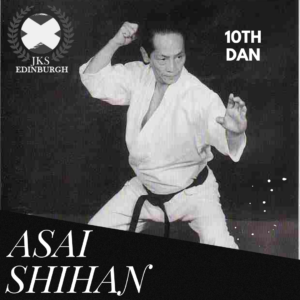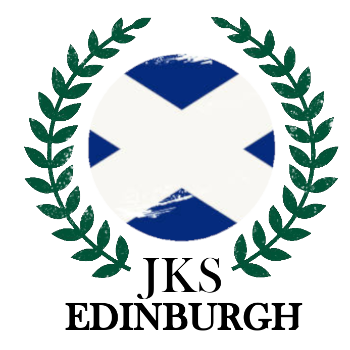Tetsuhiko Asai Sensei

In this, the first of three posts, we look to briefly explore the linage of Shotokan Karate, working from our association, the JKS, back in time to Funakoshi Sensei – the founder of the Shotokan style. While the JKS is currently led by Kagawa Shihan, whose reputation and fame speaks for itself in the karate world, each of these posts will focus on a past instructor, starting with Asai Tetsuhiko sensei and the JKS.
Our club is affiliated to the Japan Karate Shoto Federation or Japan Karate Shotorenmei (JKS) which was founded by Asai Sensei in 2000. With branches and affiliated associations across the world, including Scotland. The current motto of the JKS is “Lifelong Karate-do”, meaning the promotion of karate as a lifelong study both mentally and physically, not simply a hobby. <1>
Known as the Thunder Storm, Asai Tetsuhiko sensei (1935-2006) was a renowned martial artist who was widely recognized as one of the most innovative and skilled karateka of his time.
In addition to founding the JKS he arguably pioneered early wheelchair karate, overhauled much of traditional kata training through the creation of the Junro kata range and the implementation of the koten or “ancient” kata practise and, through a very open minded approached, integrated various other arts in his practise and methods. His teachings have promoted a mindset that has allowed all ages and abilities to take up karate where historically they might not have had the same opportunity.
Sensei Nakayama once wrote; ‘Tetsuhiko Asai’s ever-changing movements, sometimes resembling a dance performed in the air, leave spectators gaping with admiration. His inimitable talent has its source in training since youth, fostering powerful hips, a flexible body, deep technical skill, excellent reflexes and nerveless courage.’ <2>

Asai sensei was born in Ehime, Japan, and his interest in karate began around 1948 when he entered Takushoku University and began training under Funakoshi Gichin sensei – The founder of Shotokan Karate, as well as Masatoshi Nakayama sensei and Teruyuki Okazaki sensei (amongst others).
In 1957, he was awarded his first-degree black belt, but in addition to his karate training, Asai Sensei was also well-versed in a variety of other martial arts, including judo, kendo, and Jodo (a stick fighting art).
In 1958 Asai sensei graduated from Takushoku University and, at the suggestion of Nakayama sensei, he enrolled in the JKA Instructors Course, graduating from the Instructors Course in 1961, alongside the likes of Katsuharu Kisaka sense, Masaaki Ueki sense, Keinosuke Enoeda sensei and Satoshi Miyazaki sensei. <3>
After spells of competition success in kata and kumite and a period in Taiwan, Asai arrived in Hawaii in 1966 to take post as Chief Instructor for the JKS In Hawaii. As the JKA’s new Chief Instructor for Hawaii, he became the third JKA instructor to teach in Hawaii after Hirokazu Kanazawa sensei and Masataka Mori sensei.
In 1969 Asai sensei returned to Taiwan where he remained until 1973. Although based in the city of Taichung, he travelled around the island with his wife and brother-in-law demonstrating and teaching Karate.
“My karate is very free and flexible, it is 100% Asai style karate, it is my way precisely. In saying that, the typical foundation is Shotokan-ryu, as that is my orthodox base in karate.” <4>
In 2000 Asai founded the International Japan Karate Association (IJKS) and also the non-profit organisation, Japan Karate Shotorenmei (JKS). Always looking to push the boundaries of Karate and personal development, Asai founded the Japan Wheelchair Karate-do Association in 2001 and developed 10 wheelchair kata and kumite routines that were designed for use and adaptation depending on the users physical ability. In September of that year, the 1st World Shotokai Karate-do Championships and Wheelchair Karate-do Championships were held by the JKS. <3>
Asai Sensei was described as “the instructors instructor” playing a significant role in the development and dissemination of karate throughout the world and writing numerous books on karate. His approach to karate was characterized by his willingness to experiment with new techniques and his dedication to pushing the boundaries of what was possible within the art with numerous anecdotes of him learning techniques and drills from other martial arts regardless of their origin to encompass in his own training.
This open-minded approach is described briefly by him during one of his interviews:
“In the past not everybody could do Karate in the standard way, particularly after the war, there was a closed-off mentality, a physical hardness in karate, aiming primarily to build spirit, rather than effective martial arts technique. Many people in Shotokan had, and still have, closed minds thinking this is the only way to do karate, and this permeates throughout all the aspects of their training.” <3>
Asai sensei’s legacy leaves a plethora of ideas, kata, styles and methods across the world. His loss in 2006 was felt across the entire spectrum of karate and martial arts. He was a true master and innovator and we are very thankful to be a small part of his legacy.
References:
<1> From <https://jks.jp/en/about_en/>
<2.> From <theshotokanway.com/tetsuhikoasaiprofile.html>
<3> From <Spotlight: Tetsuhik Asai>
<4> From Asai Sensei Interview 2
